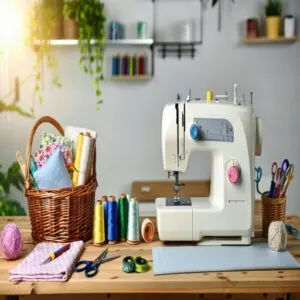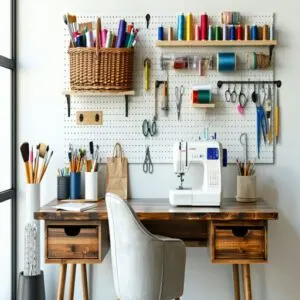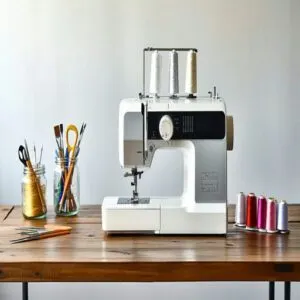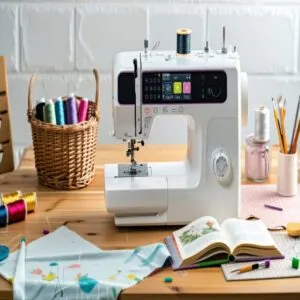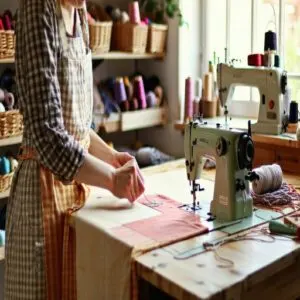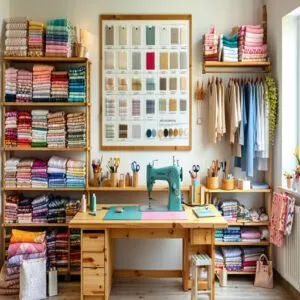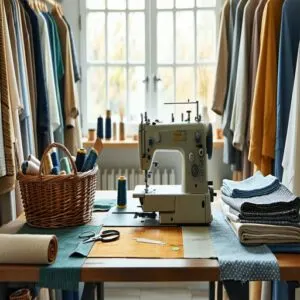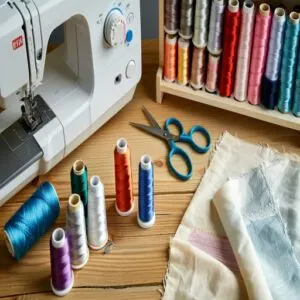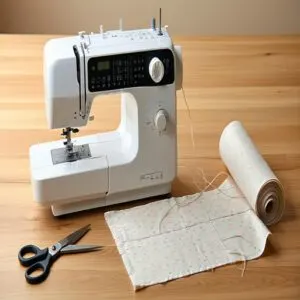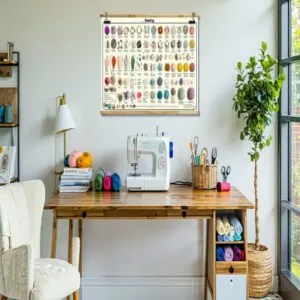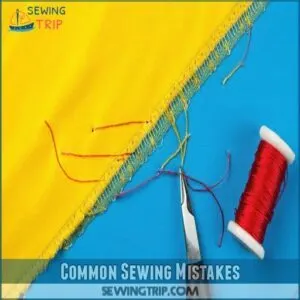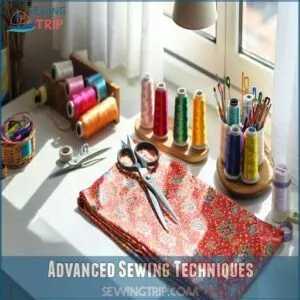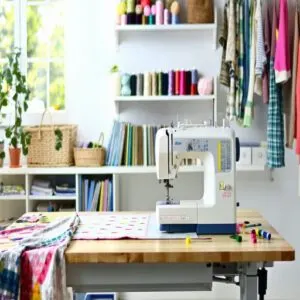This site is supported by our readers. We may earn a commission, at no cost to you, if you purchase through links.
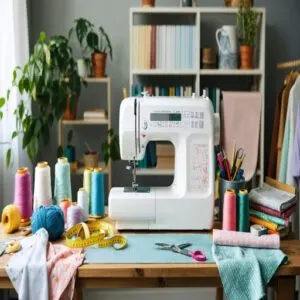 Basic sewing skills training sets you up for stitching success with a mix of machine and hand techniques.
Basic sewing skills training sets you up for stitching success with a mix of machine and hand techniques.
Start by gathering essentials: a sewing kit with sharp scissors, needles, thread, and a trusty tape measure.
Learn to thread your machine—it’s like a sewing rite of passage! Master simple stitches like the running stitch for hand sewing and practice sewing straight lines with your machine.
Don’t fear fabric curves or corners—they’re not as tricky as they seem with practice.
Mistakes happen, so embrace them as lessons. Keep practicing, set small goals, and soon you’ll be sewing like a pro.
Curious what’s next?
Table Of Contents
Key Takeaways
- Gather essential tools like sharp scissors, needles, thread, and a sewing machine to set yourself up for success.
- Practice simple stitches, like the running stitch by hand and straight lines on a machine, to build your confidence.
- Learn to choose the right needles, threads, and fabrics to match your projects and improve stitch quality.
- Set up a well-lit, organized workspace and focus on small, achievable goals to grow your sewing skills.
Sewing Essentials Found
Before you start sewing, you’ll need a solid stash of essentials to make things smooth and fun.
Don’t worry, it’s mostly simple stuff like thread, needles, and maybe a trusty sewing machine—your new best friend!
Learning Sewing Terminology
Don’t let sewing lingo trip you up!
Learning sewing terminology is like picking up a new language—it makes projects smoother and less head-scratching.
Grab a sewing glossary to decode fabric terms, needle types, and thread weights.
For example, a "selvage edge" isn’t fancy jargon; it simply refers to the fabric’s finished edge.
Mastering sewing fundamentals starts here!
Choosing Basic Supplies
A good sewing kit is your new best friend.
Start with sharp fabric scissors (don’t use them on paper!), assorted sewing needles, colorful thread, and a tape measure.
Add pins, a seam ripper, and basic sewing patterns to keep things fun.
Durable tools save headaches, so invest wisely.
Trust me, these sewing supplies make all the difference!
Having the right sewing kits can substantially improve your sewing experience.
Selecting Beginner Machine
Choosing a sewing machine for beginners doesn’t have to feel like rocket science! Look for simplicity, useful features, and budget-friendly options.
When selecting a machine, consider checking best sewing machines for guidance on key features.
- Focus on essentials: Machines with straight and zigzag stitches are your best bet.
- Ease counts: Go for automatic threaders or drop-in bobbins to avoid headaches.
- Read reviews: User reviews can reveal hidden gems or deal-breakers!
Setting Up Workspace
Creating a comfy sewing workspace makes your projects more fun and less messy. Clear off a table, grab good lighting, and you’re ready to roll!
Designating Sewing Area
Finding your groove with sewing basics starts with setting up a comfy sewing workspace.
Whether it’s a spare room or a small desk, keep it well-lit and organized.
Use baskets or shelves for your sewing kit essentials and tools.
Got limited space? Stack smart!
To maximize your space, consider creating a sewing room layout that promotes efficiency and comfort.
| Tip | Why It Helps |
|---|---|
| Workspace Lighting | Avoids eye strain. |
| Ergonomic Setup | Comfort matters! |
| Storage Solutions | Keeps tools handy. |
Essential Equipment Setup
A tidy sewing space makes everything easier, trust me.
Start with a sturdy table for your sewing machine—it’s your sewing table setup HQ.
Keep things organized enough to find what you need without a scavenger hunt.
- Store your tools smartly: Use jars or baskets for scissors, pins, and thread.
- Maintain your machine: Dust and oil it regularly for smooth sewing machine operation.
- Use pegboards or drawers: Perfect for workspace optimization and storage solutions.
Mastering Machine Sewing
Learning to use a sewing machine can feel tricky at first, but you’ll catch on fast with practice.
Once you’ve got the hang of threading, tension, and basic stitches, you’ll be off and running—no sewing injuries required!
Machine Operation Basics
Once your sewing area’s ready, it’s time to master the machine controls.
Get comfy with speed settings; practice slow and steady—like driving in a parking lot!
Experiment with stitch variation and learn smooth fabric handling.
Adjust the machine tension for clean lines, and never rush thread management—it’s the glue holding machine sewing basics together.
Watch—it’ll soon click!
Threading Sewing Machine
Threading your machine can feel tricky at first, but it’s easier than untangling headphones.
Check your sewing machine guide for diagrams of spool pins and thread paths, and follow them step-by-step, taking care not to skip guides—trust me, threading issues get annoying.
Practice makes perfect, and proper sewing machine threading keeps stitches neat and thread tension smooth.
Ready? You’ve got this!
Adjusting Tension Properly
Once you’ve threaded your machine, it’s time to tackle sewing machine tension.
Think of tension control as the Goldilocks rule—too tight or too loose and your stitches won’t behave.
Adjust it slowly using your machine’s tension dial, testing on scrap fabric until the thread balance feels just right.
Stitch quality improves when machine calibration matches your project’s needs.
Hand Sewing Techniques
Hand sewing might sound old-school, but it’s a handy skill you’ll love having up your sleeve.
From fixing a tear to sewing on a button, you’ll feel like a sewing pro in no time!
Basic Hand Stitches
The running stitch is the king of basic hand sewing stitches – simple, quick, and handy for joining fabrics.
Keep your stitch length even; too tight, and you’ll pucker the fabric.
Mastering the backstitch next is like gaining “stitch glue” for strength.
Hand sewing basics build confidence, so grab your needle, relax your fabric tension, and get started!
Choosing Right Needle
Not all sewing needles are created equal, and picking the right one feels like matchmaking.
- Use sharp needles for tightly woven fabric.
- Choose ballpoint needles for knits—less fabric damage.
- Match needle size to thread thickness.
- Thread too tricky? Grab a needle threader.
- Stick to slower sewing speed till you’re confident.
Understanding various sewing needles types is essential for successful projects.
Right needle = smooth stitches, happy fabric!
Understanding Thread Types
Now that you’ve got the needle sorted, the thread game begins.
Thread weight matters—light for delicate fabrics, thicker for heavy-duty jobs.
Fiber content, like cotton or polyester, pairs with fabric type.
Yarn texture stays smooth for easy sewing techniques.
Color matching keeps your work seamless, while thread durability guarantees it all holds tight.
Mastering this? Sewing basics made better!
Understanding thread types is also vital for a strong stitch.
Working With Fabrics
When you’re working with fabrics, knowing the difference between cotton and silk isn’t just fancy trivia—it’s the key to sewing success.
Don’t worry if it feels tricky at first; with practice, you’ll match the right fabric and thread like a pro!
Identifying Fabric Types
Ever wonder why some fabrics feel silky while others scratch like a wool sweater?
That’s fabric classification at work! Understanding fabric types, like cotton or polyester, is a sewing basic you’ll thank yourself for knowing.
Pay attention to fiber identification—natural vs. synthetic—and memorize fabric terms.
Trust me, mastering textile analysis makes every material feel less mysterious!
Understanding Fabric Properties
So, now that you know fabric types, it’s worth understanding properties like fabric density and thread count.
These affect how it feels and behaves.
Fiber content impacts stretch, while weave types control strength and appearance.
Texture analysis? That’s just fancy talk for figuring out if it’s smooth or bumpy—key to avoiding unexpected fabric puckering during sewing projects, which involves understanding the thread count.
Choosing Right Thread
Picking the right thread isn’t just about grabbing the closest spool.
Match thread weight and fiber types to your fabric—cotton for cotton, polyester for stretchy blends.
For color matching, go a shade darker; it blends better.
And remember, cheap thread can jam your machine, so smooth stitching starts with good yarn selection.
Bonus tip: texture matters too!
Sewing Machine Skills
Using a sewing machine might feel a bit scary at first, but don’t worry—you’ve got this.
Once you learn the basics, like sewing straight lines and backstitching, you’ll be stitching like a pro (or at least impressing your cat).
Straight Line Sewing
Straight stitching is the bread and butter of basic sewing skills.
Start by aligning the fabric edges carefully—good Fabric Alignment sets the stage.
Use Sewing Guidelines, like tape, to keep your line steady.
Adjust the Stitch Length (2-3mm) for smooth Seam Quality, and check Thread Tension.
With practice and sewing tutorials, your lines will be straight as an arrow!
Sewing Curved Lines
Straight lines are great, but sewing curves and corners? That’s next-level sewing!
Start small—rounded edge sewing on basic sewing projects sharpens your skills.
- Use pins generously to shape fabric into arcs.
- Sew slowly—speed kills precision.
- Shorten stitch lengths for tight curves.
- Clip seams to prevent puckering.
You’ve got this!
Backstitching Techniques
Mastering the backstitch is like building the backbone of sewing basics—it secures seams and boosts fabric stability.
To start, sew forward a few stitches, then reverse for stitch control, repeat this "dance" to lock threads in place.
It’s simple but mighty for thread management, practice this essential move, and your sewing skills training will climb new heights.
Learning Sewing Independently
You can teach yourself sewing at home with just a little time, patience, and the right resources.
Online courses and YouTube tutorials are like your sewing cheerleaders—helping you learn everything from threading a needle to stitching your first project.
Online Sewing Courses
Online sewing courses are a game-changer for learning at your own pace.
Platforms like Skillshare and Udemy offer lessons that fit beginners or those leveling up their skills.
If patterns confuse you, check out Creativebug’s tutorials.
Want step-by-step guidance? Sew It Academy’s got you covered.
These digital workshops save time, cost less than in-person classes, and help you nail sewing skills training from your couch.
YouTube Sewing Tutorials
YouTube is your sewing buddy offering free sewing lessons at your pace.
Find easy sewing tutorials like "Beginners Sewing Course" or fun projects like scrunchies with hidden pockets.
Channels like Sewing Times explore advanced hacks, while Nancy Kwon nails DIY bag designs.
For project inspiration, explore these sewing machine projects for beginners.
Tutorial reviews and step-by-step video lessons cover sewing basics, machine settings, and mistakes to avoid.
It’s like sewing workshops—online and ready anytime!
Common Sewing Mistakes
Messing up is part of learning, so don’t sweat it if your first seam looks like spaghetti.
Let’s spot those common sewing mistakes and fix them before they ruin your project, which involves sewing mistakes.
Avoiding Beginner Errors
Starting out can feel like threading a needle in bad lighting, but beginner sewing projects don’t have to be messy.
Watch out for skipped stitches or wrong thread tension—these can mess up stitch quality.
Handle fabric gently and check thread management to avoid tangles.
Sewing basics like measuring twice and cutting once save headaches, and error prevention is smart sewing!
Correcting Common Mistakes
Mistakes happen, but they’re fixable!
Uneven seams? Use seam rippers like a pro to reset.
Faulty stitches? Check thread tension—it’s often the culprit.
Fabric puckering? It might be the wrong needle or tension setting.
For sewing troubleshooting, pause and analyze the mistake.
Understanding common sewing errors is key to improving your sewing skills.
With repair techniques and a little patience, you’ll turn those sewing mishaps into mastery!
Keep problem-solving!
Preventing Project Ruin
Skipping fabric prep or misreading sewing instructions can unravel your hard work—literally.
Error prevention starts with accurate fabric selection and thread management, pin patterns securely, double-check tension control, and don’t skip seam reinforcement for sturdy stitches.
Practice these sewing basics, and if something’s off, try simple sewing troubleshooting.
Stick to consistent sewing tips, and keep mistakes from derailing your progress!
Advanced Sewing Techniques
You’re ready to step it up and tackle some exciting advanced sewing techniques.
From sewing crisp mitered corners to mastering invisible zippers, these tricks will make your projects look polished and professional—let’s make it fun!
Sewing Mitered Corners
Ever struggle with crisp corners?
Mitered edge techniques are your secret weapon!
To miter corners, fold the fabric diagonally at the edge, aligning seams perfectly—it’s like origami for your sewing project.
Use precise corner stitching to keep it neat.
Mastering mitered corner techniques is essential for achieving professional-looking results.
This fabric corner method is all about angles and focus, so practice these sewing instructions to nail it every time, using mitered edge techniques to ensure success.
Using Invisible Zipper
Switching from sharp corners to sleek closures, sewing an invisible zipper adds elegance to any project.
Use a zipper foot for smooth installation, keeping seams perfectly concealed.
Pin the zipper carefully and sew close to the teeth for that flawless invisible look.
Practice on scrap fabric first—nailing this will make you feel like a sewing pro.
Stay patient, it’s worth it!
Creating Seam Finishes
If you’ve tackled invisible zippers, seam finishes are your next big win.
They keep raw edges neat while boosting durability.
Try French seams for sheer fabrics or serged seams for fast fray prevention.
Feeling fancy? Hong Kong seams add flair with colorful fabric binding.
Even a basic zig-zag stitch works wonders.
Your edges deserve as much love as your zippers!
Improving Sewing Skills
You’ve got the basics down, so now it’s time to level up your sewing game.
With regular practice, clear goals, and some teamwork from fellow sewists, you’ll be stitching like a pro in no time.
Practicing Regularly
Building a daily sewing routine is like watering a plant—you’ve gotta keep at it to see growth.
Practice stitching straight lines on scraps or try small, simple projects.
Consistent skill building turns beginner sewing into second nature.
Don’t worry about perfection; even crooked stitches teach you plenty.
Regular sewing practice tips? Start easy, stick with it, and watch yourself improve over time with consistent skill building and regular sewing practice.
Setting Achievable Goals
Small wins add up fast!
Start with simple Goal Setting Strategies—like stitching a straight seam or finishing a pillowcase.
These Sewing Milestones build confidence.
Got 10 minutes? Work on Project Planning or practice basic sewing skills.
Time Management keeps things moving!
Remember, sewing for beginners is about progress, not perfection.
Stick to achievable goals, and you’ll love the journey.
Joining Sewing Community
Finding a sewing community is like discovering a secret stash of fabric and friends.
Join local sewing groups or hit up online forums packed with advice.
Community events and sewing meetups let you swap tips or show off your projects.
The member benefits? Fresh ideas, support, and shared laughs, it’s perfect for beginners craving connection while learning sewing basics!
Frequently Asked Questions (FAQs)
How to learn sewing basics?
Jump in with both feet by grabbing a beginner sewing machine or hand needles, cotton fabric, and thread.
Watch free YouTube tutorials, practice simple stitches, and tackle easy projects.
Mistakes? They’re just part of learning, and with time, you’ll master the craft, including understanding that errors are an essential step in the process of learning sewing.
What are the basic skills needed to learn sewing?
You need to nail the basics: threading a needle, sewing straight lines, learning simple stitches, and understanding fabric types.
Practice patience—it’s key. Start small, like fixing a button, and build confidence project by project, which helps in mastering the basics!
Should you learn to sew by hand?
Learning to sew by hand is a smart move.
It’s like building a foundation—once you nail simple stitches, you can tackle repairs, creative projects, or even add flair to clothes without a machine.
What is a learn to sew course?
A learn-to-sew course is your shortcut to sewing confidence.
It walks you through the basics—stitches, tools, and fabrics—step by step.
Perfect for turning “I can’t” into “I made this!” without breaking a sweat.
Is it time to practice sewing for beginners?
Think of sewing like riding a bike—awkward at first, but practice turns wobbles into smooth rides.
Start with simple stitches, repeat often, and trust me, you’ll gain confidence faster than you think.
What is a free beginner sewing course?
You can explore free beginner sewing courses like Tilly and the Buttons’ blog or Made to Sew’s YouTube channel.
They walk you through simple, fun tutorials—perfect for getting those creative vibes flowing!
How to teach basic sewing skills?
Start simple—teach them to thread a needle and sew a straight line.
Break it down into fun, bite-sized steps, like stitching a pillowcase.
Celebrate small wins, and soon, they’ll feel unstoppable!
What is the first thing a beginner should sew?
Think of sewing like cooking your first pancake—it’s all about keeping it simple.
Start with a basic pillowcase, it’s straightforward, forgiving, and a perfect way to practice stitching straight lines and creating seams.
Can I teach myself sewing?
Grab some fabric, a needle, and thread, and get started.
Online tutorials and YouTube are goldmines for tips.
Mistakes will happen, but that’s how you get better—one stitch at a time!
How to learn stitching at home for beginners?
Think of stitching as your new superpower—grab a basic sewing kit, watch beginner-friendly YouTube tutorials, and start practicing simple stitches on scrap fabric.
Mess-ups happen, but that’s how you level up your skills fast with simple stitches!
Conclusion
You’re not just learning sewing—you’re discovering a superpower!
With basic sewing skills training, you’ve got everything you need to tackle projects big and small.
Remember, patience and practice are your best friends here.
Start simple: master straight lines, basic stitches, and know your tools.
Don’t sweat mistakes; they’re just part of the fun.
Before you know it, you’ll be whipping up creations you’ll be proud to call your own.
Grab that needle and thread—it’s time to shine!
- https://digitallearningedge.com/basic-sewing-skills/
- https://sewing.com/basic-sewing-skills/
- https://www.charlottesewingcenter.com/module/class/112331/beginner-sewing-1---2022
- https://www.sewingcrafty.com/39-must-learn-basic-sewing-skills-for-beginners/
- https://www.internationalschooloftailoring.com/basic-sewing-skills-playlist

